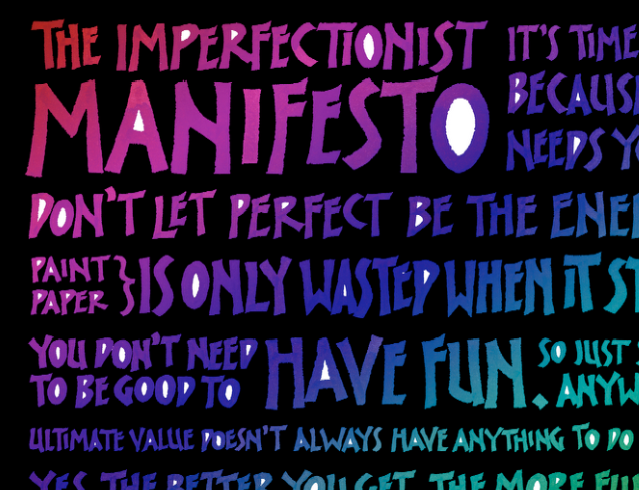
I have a new goodie for you! Over the past week I’ve been hard at work on artwork for my Imperfectionist Manifesto. I just made it available as a poster in different color options over at my Zazzle shop (and I’ll soon send my subscribers a link to get a free, printable PDF, along with the PDF of my Keys to Creative Flow).
There’s a story behind this artwork, though, both the creation of it, and the sharing of it — a story that includes being bashed on my own Facebook page. I learned a lot from this experience, and it felt important for me to share what I learned, so you can benefit from it, too.
Read on…
Prologue: What Led to the Imperfectionist Manifesto Poster
Some years ago I realized that dropping my perfectionist ways was essential if I ever wanted to finally rid myself of the core feeling that I’m not good enough. This was not an easy prescription to follow, though. A lifetime of perfectionism is not something one can just make disappear — *poof!*
Writing is one way that I figure out what I think, so back in July of 2011 I wrote a blog post called The Imperfectionist Manifesto, exploring my evolving feelings on the subject. Ever since then I’ve wanted to expand on the bullet points I came up with in that post and draw up a visual manifesto, something I could print out and hang on my wall.
At the time of this writing, it is now February of 2014. Ahem. Why did it take 2 1/2 years to create an Imperfectionist Manifesto poster? Take a guess.
Yep: perfectionism!
A manifesto poster must be awesome (I thought). It must be remarkable! Amazing! And that felt so far beyond my abilities that, without quite realizing why I was doing so, I shelved the idea entirely.
The patterns of perfectionism run so deep, they tick away even when we’re not consciously aware of them.
Which is why I’m such a strong proponent of imperfectionism! Perfectionism poisons our lives, stunts our growth, keeps us trapped in a tiny, little box, afraid to move. But when you’ve been in that box your whole life, it feels normal — safe, even.
It takes ongoing effort to bust out of the perfectionist box. Imperfectionism is the antidote.
[Tweet “It takes ongoing effort to bust out of the perfectionist box. Imperfectionism is the antidote.”]
Beware the Imperfectionism Haters
Not everyone takes kindly to the suggestion of such change, though. Be advised, if you join me in the ranks of the imperfectionists, that you may encounter resistance not just inside yourself, but coming at you from others.
Why?
Perfectionism allows us to stay paralyzed. When we’re afraid of the judgment we might get for being less than perfect/awesome/remarkable/amazing, we all-too easily slip into the habit of never sharing our work — or never even starting — with the convenient excuse that “it’s/I’m not good enough yet.”
We can pretend to feel superior (after all, we never share anything until it’s perfect!), and we can imagine that we’re safe (nobody can judge us if we don’t share!).
In fact, it’s a very anxiety-filled way to live — I should know, because this describes me to a T until just a few years ago.
When you’re hiding behind a perfectionist smoke screen, witnessing someone else take the imperfectionist path is threatening! If perfectionism isn’t the sanctioned excuse anymore, it blows away the smoke screen that was offering the only (though false) sense of security.
When people don’t feel safe, they can react in ways that seem strange, including sometimes lashing out at what they perceive as the source of threat.
I was the target of such lashing this weekend, when I shared process pics of my Imperfectionist Manifesto this weekend.
The experience got me thinking. It raised some important issues that felt worthy of addressing here.
But first, for those with an interest in the creation process, let’s start with…
Part 1: Creating the Artwork
Creating the Original Art
On Wednesday of last week I was fired up to do this thing! I started work on the on the wording and layout for the poster.
First, I created a mockup in the computer, using Adobe InDesign. I made several trials — unfortunately I don’t have the first few to show you (note to self for next time: remember to take screenshots early in the process!), but here’s an early-ish version:
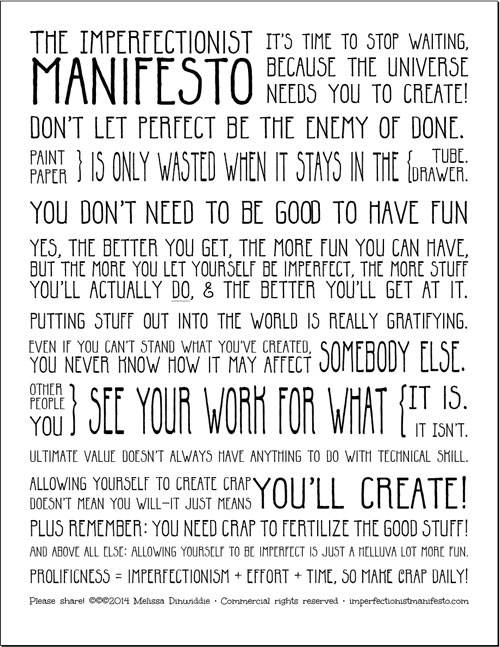
And, after lots of tweaking of the layout and moving lines around, here’s the final version:
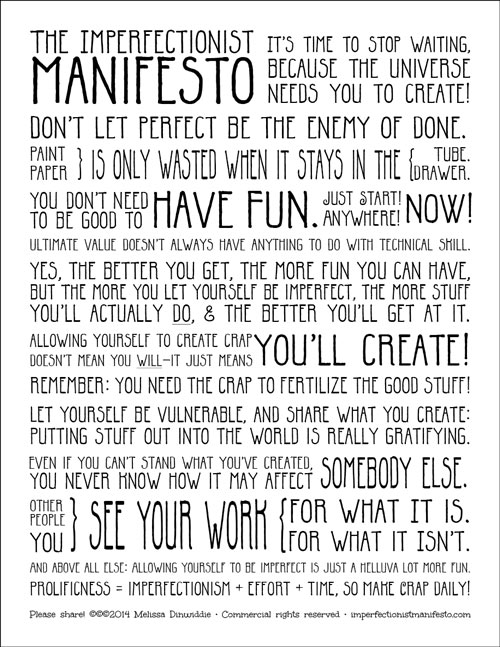
Kinda cool looking in its own right, but an Imperfectionist Manifesto needs to be written by hand! Besides, I’m a calligrapher. It’s what I do.
I printed this final mockup — four sheets of letter paper — and taped them together to use as my visual guide and as a guard beneath my writing hand while doing the calligraphy. It also provided a template for drawing pencil lines onto the watercolor paper I would use for the original artwork.
(Note: Yes, in case you’re wondering, I did contemplate not using any lines at all, which would have been highly appropriate for an Imperfectionist Manifesto. Ultimately, though, I decided to prioritize legibility over pure artistic expression and “imperfectness” for this piece. Perhaps I’ll make another, messier Imperfectionist Manifesto poster later…)
As I did with my Keys to Creative Flow poster, I decided to do the calligraphy in walnut ink (my fave!), and then play around with adding color in Photoshop later. Unlike the hot press (smooth) watercolor paper I used for the Keys poster, though, for the Imperfectionist Manifesto I intentionally chose cold press watercolor paper, which has a textured surface, because I wanted the letters to look even more irregular and “imperfect.”
Here’s a snapshot demonstrating how I use the printed mockup as a guide, right below the line of lettering (it also serves to protect the paper from absorbing oils from my skin, which can cause the ink to bead up and skip):
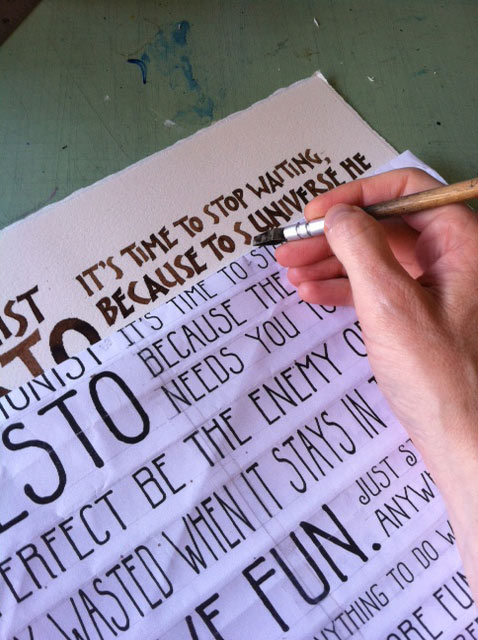
Right below my pen you’ll also see one of the hazards of using a guide like this: in the second line of calligraphy — a glaring mistake! Instead of calligraphing “because the Universe,” I started to write “because to stop waiting.”
Oops…
(Calligraphers are notorious for “typos” like this, and we’re often accused of being terrible spellers. In fact, these types of mistakes have nothing to do with our ability or inability to spell; they’re a product of the right brain/left brain split. When we’re lettering, we’re focusing on shapes, which is a right brain activity, but reading is a left brain activity! It’s impossible to do both at the same time. And because I’d been lazy and not folded my guide paper down to the next line [thinking I’d surely remember to write the correct line], my right brain just started copying what was directly beneath my hand.
I had a feeling this might happen… Lesson: always trust your gut on these kinds of things, and take the extra time to fold the darn paper down!)
After a moment of annoyance, I had a good laugh. I’d kind of hoped to be able to hang the original artwork on my wall, but the real product was going to be the posters that came out of the printable digital file, and I knew I’d be fixing that up in Photoshop anyway. And how poetically appropriate to make an early mistake like this on an Imperfectionist Manifesto!
Little did I know that this “typo” (which of course isn’t actually a typo, since it’s not type) would be the cause of some major Melissa-bashing later on… But I’ll get to that later…
I forged ahead, grateful that this wasn’t a one-off commission for a client, which would require me to line up a new sheet of paper and start all over again…
(Yes, I’ve done that before. Many times. And usually the mistake was closer to the last line, rather than up at the top…)
Work proceeded. Slowly. Lettering like this is very time-consuming.
It also hurts my body. It asks my hand to do things hands were not intended to do for long stretches of time (if at all!), and same thing for my back and neck. What I could manage without too many after effects at 28 or 30 is just crazy now, at 47! Ideally I’d letter for ten or fifteen minutes at a time, then take a five minute break to stretch, walk around, do some yoga.
Ha! I get very “OCD” when I’m working on a piece like this, and I was really eager to get it done. So I plowed on through, with not nearly as many breaks as my body really wanted… (Do not try this at home!)
My obsessiveness paid off though. On Saturday, around noon, I finished the calligraphy, and rather than hiding my mistakes and imperfections, I shared this snapshot on Instagram, Twitter, and my Facebook page and profile:

Creating the Digital File
Now that the original artwork was done, it was time to get this puppy digitized, so I could muck around with it in Photoshop, fix mistakes, tweak the layout, remove splotches, etc. This is a big monster of a job in itself, which probably takes about the same amount of time as lettering the original art. Te first step in the process was scanning.
Since the art was about 17×22, and my scanner is a bit more than letter size, I had to scan in four passes, which, layered roughly in Photoshop, looked like this:
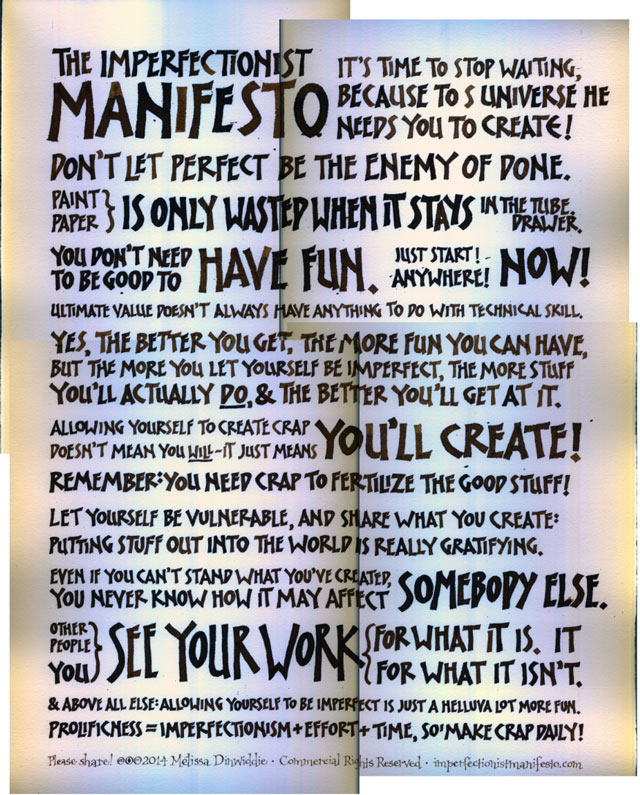
(As you can see from the crazy colors going on here, I’m overdue for a new scanner… What a mess!)
If I’d been smart, and more patient, I’d have paid a pro to get a high quality digital capture in one pass, but I was eager to get this done over the weekend, so I dove into making this big, ol’ mess look pretty.
Not a task for the faint of heart!
Thankfully, I’ve paid my Photoshop dues, and have learned quite a few tricks. Dozens of Photoshop adjustment layers later, I had some images that I was starting to feel good about!
I made four different color variations and shared them on my Facebook page to see which one(s) people liked best:
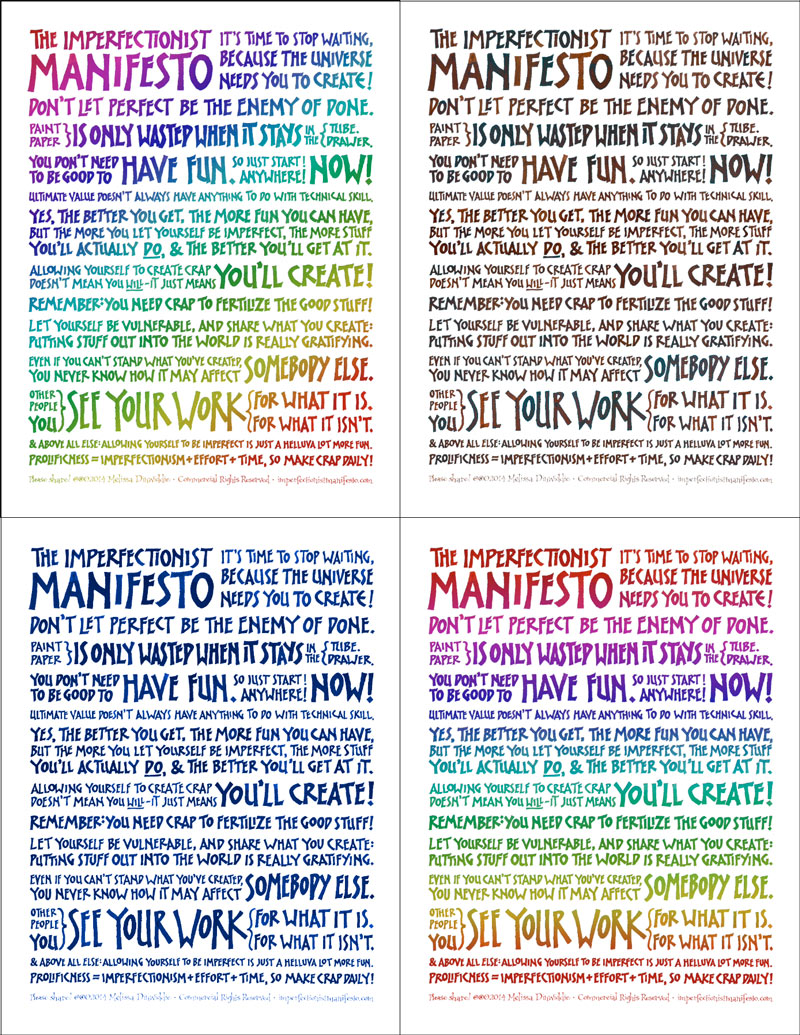
The diagonal rainbow design, shown at top left, was by far the favorite, though the others got lots of thumbs up as well. Some people preferred the greater legibility of the walnut ink brown (still my favorite, I think).
Then when I was fiddling with the file some more to create final versions for uploading to my Zazzle shop, I inadvertently landed on this one, which kinda blew my socks off:
And the other two, also now available as posters in my Zazzle shop:
So that’s the story of how this poster came to be. And yes, please share these images! They’re marked with a Creative Commons license to show that I DO want you to share!
The posters are all marked with “Commercial Rights Reserved,” because I do want to reserve the exclusive right to sell my art, but I’d love to see the web images spread far and wide, to inspire as many people as possible to join the imperfectionist movement, so share away!
The creative process report ends here, but it’s not the end of the story. What follows is an unpleasant tale that led me to do some hard thinking about how best to communicate my philosophy, without being misunderstood. I’m still thinking about that, in fact, and suspect I will be for a long time to come.
Here’s what happened…
Part 2: Enter the Troll
Remember that snapshot of the finished original artwork? This one:
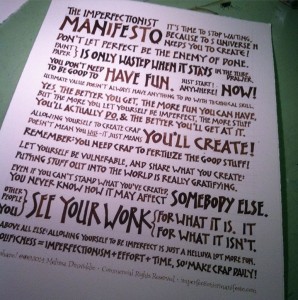
Well, it caused some disgruntlement over on Facebook…
I posted that pic, along with the following comment:
I finished the original artwork for my Imperfectionist Manifesto and scanned it last night (yes, there are mistakes on it! So appropriate, no?)
This weekend I want to make strides on Photoshopping it to create a poster, like my Keys to Creative Flow. (And like the Keys, I’ll be giving a printable version away to subscribers — yay!)
What are you working on this weekend?
That’s when the bashing started.
Most people left quite positive, enthusiastic, encouraging comments. Some asked how they could get ahold of posters.
One person, though, had quite a different reaction. Over on my Facebook page, she wrote:
You know, if I was going to produce original artwork to distribute as a reflection of me and my my work, i (sic) would certainly work to produce a piece without mistakes. I get so tired of supposed professionals who tell us to excuse their sloppiness and not doing (sic) good work. Imperfectionist or not you guide others by example. I sure wouldn’t be inclined to do business with, or take training from someone who won’t take time to produce a quality product. Being done is not always the goal to strive for. I AM a professional at what I do and I guarantee my work or I don’t let it go. I spent years working at my work before it was ready to fly on its own. Would you excuse a Dr (sic) or Lawyer (sic) who did less than their best work for you? Think about it.
Huh. I confess I was a bit taken aback by the tone, and the implication that I was acting in an unprofessional manner, that I was telling people to “excuse my sloppiness and not doing good work,” that I won’t take time to produce a quality product, that I let my work fly before it’s ready.
This, dear reader, is known as slander.
However, I wanted to give the commenter the benefit of the doubt. I could see that my shorthand of “Photoshopping it to create a poster” might not be understood by someone without an appreciation of the process involved in creating a work for reproduction.
After all, I didn’t state explicitly that one of my main goals with Photoshopping would be to fix the mistakes I mentioned. Anyone with experience making work for reproduction would understand this, but I can’t expect people without such experience to know it!
Lesson: if you don’t want to be misunderstood, communicate as if you’re dealing with someone who has absolutely no understanding.
If I had done that, instead of the shorthand I used above, I would have written something like this:
I finished the original artwork for my Imperfectionist Manifesto and scanned it last night (yes, there are mistakes on it! Of course I will fix those in Photoshop, so they won’t appear on the printed posters, but there’s something poetically appropriate about mistakes on the original, no?)
This weekend I want to make strides on Photoshopping it to create a poster, like my Keys to Creative Flow — adjusting the layout, fixing the mistakes, playing with color variations, etc. (And like the Keys, I’ll be giving a printable version away to subscribers — yay!)
What are you working on this weekend?
Alas, Facebook doesn’t allow for edits on posts on pages. I contemplated not replying at all, but it did feel important to clarify my process for anyone else reading, so they would understand that the commenter’s accusations were unfair. So I replied directly to the commenter’s comment:
You jumped to some rather extreme conclusions here, [Name Withheld]. If you’d taken the time to ask, rather than making assumptions, I would have explained that finished original artwork is just a starting place, not the final product.
Meanwhile, others jumped to my defense in the comments as well. (And I’ve since received emails and Facebook messages from yet others who wanted to let me know they were steaming under the collar after reading the commenter’s implied slander.)
Alas (again), it became instantly clear that the commenter was not interested in reason — she was interested in being a troll. Here’s her next response:
I called it as I saw it and went by what she actually said. Nowhere did she say it was a draft version. If I let ppl in on work in progress, I make a point of telling them it is that. I see way too many ppl on Facebook and other platforms rushing their work out as if quantity was more important than quality. And, moreover, that putting out less than quality work is something to be admired. I feel differently and said so. I stand by my comments. We can agree to disagree on this issue.
Huh. True, I didn’t explicitly state in my original post that the snapshot was a draft version — though we already covered that “original artwork” for a piece for reproduction by definition is a draft version. But she pointedly chose to ignore that. And once again, she implied that I was “rushing my work out” before it was ready.
And yet, she had a point: in some instances I do consider quantity to be more important than quality! For example, item #3 in my Keys to Creative Flow states quite explicitly, “Think quantity, not quality.”
Here’s where things started to get really interesting.
Now I know that “Think quantity, not quality,” is a prescription for getting blocked creatives into the playful state of flow, not a prescription for how to offer work for consumption by others. Of course we should strive for excellence in what we put out in the world. Of course we should aim to make awesome stuff.
On the other hand, when we have “make awesome stuff” at the top of our agenda, it has a nasty tendency to lock us into perfectionist paralysis! It’s precisely what kept me from even starting on an Imperfectionist Manifesto poster for 2 1/2 years!
Can you see how sticky this all is?
“Think quantity, not quality,” could be interpreted to mean, “Just be sloppy, and don’t bother with trying to do good work.” That’s absolutely contrary to what I mean by it, but when all anyone pays attention to is the shorthand, they can inject all sorts of meaning that wasn’t the author’s intention.
It really got me thinking. Annoyed as I was at having my Facebook page used as a platform to slander and bash me, I wasn’t interested in engaging with a troll, but I was interested in using this interaction to clarify my thinking for other people who might be paying attention. So, thinking of my True Fans, my Right People, I wrote the following:
Bad on me for assuming that people would understand that “Photoshopping” means fixing mistakes, tweaking the layout, and otherwise modifying the scanned original artwork. Bad on me for assuming that people know that “finished original artwork” means “rough draft, ready to be tweaked in the computer.”
Now I know better not to assume that people know this! 🙂
Quantity, I submit, IS more important than quality, when we’re looking to be in that glorious state of free-flowing creativity.
This does not mean that quality isn’t devoutly to be pursued. But focusing solely on quality is a sure route to rusted-shut creative taps. Perfectionism will do that to a person.
Years of perfectionism and knocking myself out to please clients had me completely frozen by perfectionist paralysis. It’s not something I’m alone in, either. I’d be a very rich women if I had a dollar for every person who’s ever come to me with the same problem — so tied up in expectations of perfection, or of making something “awesome,” “brilliant,” “amazing,” etc., that they can’t even start.
When I think of the years I wasted… Of the cumulative years of so many lives wasted!
I developed my Keys to Creative Flow (formerly known as my Rules for the Creative Sandbox), and my Imperfectionist Manifesto, in an attempt to get myself back to the joy I used to feel in creating, joy which had been so lost to me for so long…
And guess what — they worked!
And not just for me, either. It has been so validating to hear back from countless others who have also been helped by the “rules” I designed to get me creating again. Over a thousand people have gone through my Creative Sandbox 101 ecourse, and many, many of those have shared that it got them creating again, after years of resistance.
It changed their lives.
Embracing imperfectionism has been such a huge part of my healing, and the healing of so many clients of mine. And yet, it’s a tricky balance, isn’t it? Of course we want to make work that pleases us, work that we’re proud of!
Being an imperfectionist does not mean being sloppy. Nor does “Think quantity, not quality” (#3 of my Keys to Creative Flow). It’s unfortunate that people may misinterpret it to mean sloppiness. It does not, and every article I’ve written and presentation I’ve given about my Keys to Creative Flow/Rules for the Creative Sandbox is very explicit about that.
It *does* mean to allow yourself the freedom to play in the Creative Sandbox, just as a 4-year old plays and explores in a real sandbox.
Sometimes those Creative Sandbox experiments will evolve into pieces we feel proud of, pieces we might even offer for sale. Sometimes they’re for our eyes only.
Of course, when we offer something for sale, whenever we share something with the world, the critical editor comes into play. This is not a bad thing, BUT, I also have to honestly state that if I had waited for *perfection*, none of my hundreds of happy clients would have gotten a damn thing from me.
I have never made something perfect. Never. I knock myself out in pursuit of excellence, but every single thing I’ve ever made has something that I wish I’d been able to do better.
I’m learning to be okay with this, while at the same time constantly striving to get better.
Should I hold my creations back because they’re not perfect? My clients would have been mighty disappointed, let me tell you. The happy and satisfied purchasers of my music, my original paintings, my teaching services, would have missed out.
The truth is, none of us is the best judge of our work. At some point, I believe it is beholden on us to let those who appreciate our creations determine that yes, they are ready!
If someone is asking to buy something I don’t feel satisfied with, who am I to pronounce that *my* judgment is superior to theirs? That’s downright insulting.
And yes, mistakes are part of the game. When we don’t allow and forgive ourself for mistakes, once again, we freeze. And how very sad that is.
Where does this leave us? In an ongoing state of balance and discovery — chasing after excellence, while letting go of it at the same time. Endeavoring to focus on process, while at the same time aiming for a quality product.
It’s rather Zen. Very contradictory, yet what else can we do? As creators, we must create, so we must keep that creative channel open, which requires imperfectionism. We must allow ourselves to create crap — as it says on my Imperfectionist Manifesto, when you allow yourself to create crap it doesn’t mean you WILL, it just means you’ll CREATE!
And as creators, we must also strive for excellence, which requires judgment.
We must use both together, as difficult as this is. It is the work of a lifetime. It is our Great Work. It is incredibly challenging, and as with most challenging things, it has the potential to be incredibly rewarding.
This is as true with life — relationships, parenting, business… — as with art. We must allow ourselves to make mistakes, otherwise we freeze and nothing grows.
This is our Great Work. Our lifelong Great Work.
Here’s to doing the work!
I felt rather pleased with this. I believe all of this with my whole heart. And I really hoped my heartfelt intentions would be clear to the commenter, though I suspected that wouldn’t be the case. She’d certainly given no indication so far that she was interested in actually paying attention to what I was saying — she seemed more interested in hating on me and being a troll.
My suspicions were right. Within moments she had replied:
Quite the sales pitch and self-justification. Market away. I’m not interested in what you are selling.
Huh. I’m still not clear about what in my reply above was a sales pitch. Can you tell me?
What is clear, though, is that this person is not my Right People. She had three opportunities to connect with me, and in each case she chose to lash out instead. She is a troll, pure and simple.
A Final Word About Trolls and Haters
I share this story because anyone who’s living a big, bold, creative life is going to be subject to feedback, both positive and negative. The more visible you become, the more the trolls and haters will come out of the woodwork, so it’s really important to develop a force field.
Trolls and haters will never be converted to fans. They exist to be a pain in your side. Engaging with them is pointless — they aren’t interested in being reasonable, they’re only interested in creating drama through pain.
And yet, it’s always the one negative comment among the thousand positive ones that we latch onto, isn’t it?
How often do we waste our energies trying to get a troll to see reason, to act like a human being, to love us? That, of course, is a rhetorical question. We already know the answer: way too often!
Lesson: Write for your True Fans, not for your haters. Haters won’t be swayed, but your True Fans may learn something from how you respond.
Epilogue
So far, the response to my new Imperfectionist Manifesto poster has been great. It’s very gratifying to know that lots of people out there agree that perfectionism is a curse.
And even though not everyone has responded positively, I’m so, so pleased that:
1) I managed to notice that I was stalling due to perfectionism (ie, self-awareness)
and
2) I managed to stop stalling, forgive myself for stalling, and make something, knowing that it would be imperfect! (ie, self-compassion)
Once again, as with so much in life, it all boils down to my Golden Formula: self-awareness + self-compassion = the key to everything good.
[Tweet “I love @a_creative_life’s Golden Formula: self-awareness + self-compassion = the key to everything good.”]
Enjoy, and go get creating!

PS — Pssst! Know someone who might benefit from seeing this today? Pass it on!

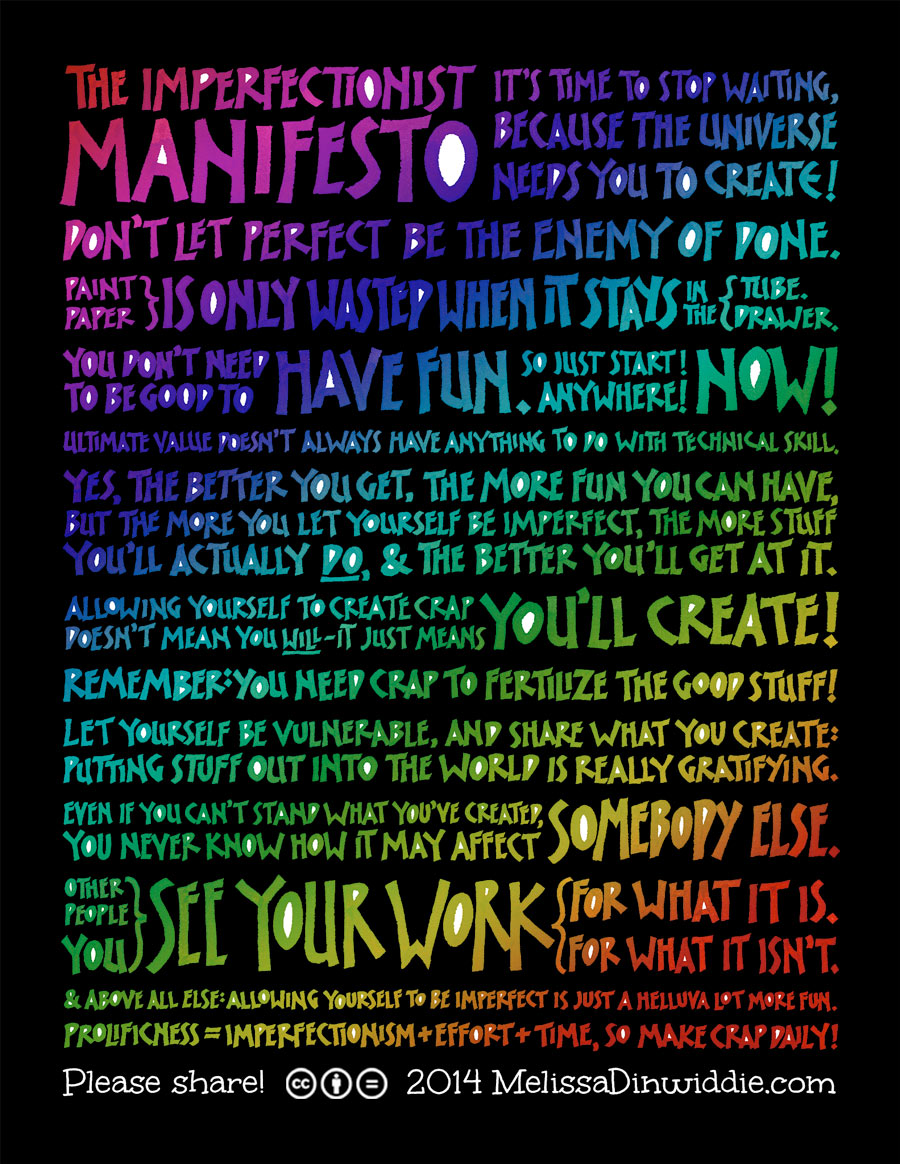






One of Julia Cameron’s 10 Rules of the Road is: “In order to be an artist, I must place this sign in my workplace: Great Creator, I will take care of the quantity. You take care of the quality.” If it’s good enough for one of the most well-known creativity instigators on the planet, I figure it’s good enough for the rest of us!
Melissa, congrats on the poster. Another inspiring job 🙂
I forgot that Julia Cameron wrote that, Laureen! I’ve always loved that quote: “You take care of the quality; I’ll take care of the quantity.” (Dang — that would have been GREAT on the poster! 😉 )
Oh how I love the poster and the layers of stories behind it! Thank you for telling all the angles and sharing not only your art, but also your kind wisdom.
Thanks, Melissa. And you’re so welcome. 🙂
Ahhh, loved the article, the new poster and how you are being an example of how to handle the nay sayers (which can be a source of crippling for us recovering perfectionists!). Good job, Melissa!
Thanks, CJ. I’m glad. 🙂 Imperfectionists unite!
How can I buy one of your posters? It is great! I grew up with a perfectionistic mom and so some of that rubbed off on me. I believe that person is probably a Perfectionist in hiding and angry with themselves. Love it! Don’t let them get you down.
Thanks, Cindy! I think perfectionism is really an epidemic in our culture. And yes, I got the feeling that the troll was a perfectionist in a big way — very threatened by imperfectionism.
You can get posters here:
Black Rainbow Poster
White Rainbow Poster
Walnut Ink Poster
Melissa, the poster looks fantastic all Photoshopped up! 😉 Even the imperfect original is fantastic – I love them all! There is always someone just waiting in the shadows to criticize, isn’t there? I’ve had my share of them, too. Some doosies don’t you know. You handled it very well and zen like. My first instinct is to be reactive – not proactive like you were here. Well done, I strive to be more like you in that way.
I just wish though there was a button we could click on ourselves to forget the one negative remark and focus on the hundred of positive ones. I’m with ya Sista! No hatin’ here. Just remember… Karma, baby. She’ll get hers.
Thanks, Jaime! And believe me, my first instinct is to be reactive, too! The challenge is learning to hold off on that initial reaction.
And yeah, if you find that button, let me know! 😉
I have always been a fan of your outlook and your work. I spent too much time trying to make everything perfect and never putting anything out. But now I see the value in getting feedback before I dismiss my work. I think it’s very fitting that your Manifesto started as imperfect – it didn’t make it any less valuable as a message. Haters gonna hate, creators gonna create!
Thanks, Katarina! And yes, that’s exactly what Miracle Man says: “Haters gonna hate.” 🙂
How ironic that this person chose to bash a poster on imperfectionism! And isn’t it interesting that nitpickers often fail to notice their own spelling or grammar mistakes or whatnot. Melissa, I’m sure if you aren’t already laughing over this whole bizarre incident, you will be soon. 🙂 Keep up the beautiful work.
I think laughter is part of how we successful deal with annoyances like this, Rebekah, though of course it’s always much easier to laugh about it later. 😉
Melissa, I love the poster(s)! I am a card-carrying member of the Recovering Perfectionists crowd as well. It is sad to think of all the wasted years waiting until things are “just right”. WRT trolling, I just read recently about some psychological research that links online trolls with sadistic personality traits (here’s one report: http://arstechnica.com/science/2014/02/science-confirms-online-trolls-are-horrible-people-also-sadists/). It’s sort of a “well, duh!” kind of scientific result, but in a way it helps me better separate emotionally from their words and not take them to heart. All the best to you!
Thanks, Katherine! And yay for card-carrying Recovering Perfectionists! Imperfectionists unite! 🙂
Very interesting about the research. And yeah, not really surprising, but I agree — knowing the scientific research is helpful for being able to separate and not take trolls’ comments to heart. 🙂
So the woman complained about the perfectionism of your piece which was about embracing imperfectionism. Hmmmm. So much irony.
Yeah, pretty funny, huh? 🙂
I just came across this poster, which is why I’m a month late to the discussion 🙂
This is fantastic advice, and not just for artists – I am writing a Masters thesis, and I (and my fellow students) would really benefit from remembering all of this! The Manifesto also reminded me of another piece of advice I struggle to follow: “don’t compare your insides to other people’s outsides”. In other words, don’t compare your first attempts at creating to someone else’s polished, published work, because you’re comparing dissimilar things – chances are, their first drafts were just as imperfect as yours are, and your finished work will be just as polished as theirs. We just don’t always show people our interim work, so we never get to compare it. So it’s especially great that you posted your scanner-ready art for everyone (yes, even the haters) to see 🙂
So glad you found it, Trixie! And I agree — it’s definitely not just for artists. Creators of ALL types can benefit from the Imperfectionist Manifesto.
I’m a big fan of “don’t compare your insides to other people’s outsides,” and “don’t compare your reality to other people’s highlight reels.” I like sharing my interim work for that reason: so people can see the mess and the imperfection! After all, I want to inspire people, and pretending that everything springs perfectly from my fingers wouldn’t be the best way to accomplish that. 🙂
I heard someone say that what other people think about you is none of your business. It took me awhile to realize that by not investing my expectations in connection with other people’s reactions to me/my art actually freed me. It’s their problem, not mine. Love the poster!
It’s often hard for me to remember that, Jo, but it is SO TRUE! 🙂 so glad you like the poster. 🙂
It is best to remember that the only person we have control over is ourselves. That it is not what happens to us but how we react to it and that is all we have control over. There are always people out there that will say or do anything to feel their control is superior and that usually means they are personally out of control.
Indeed.
Hi. You may have ” the manifesto written, ” so I can translate it to Spanish? Thanks 🙂
Ah . . . love how you break down complexities and feelings into simple steps that WORK! Perhaps one of the most important is this permission to be imperfect. It’s the door opener. Thanks!
YES! Permission to be imperfect is the hardest thing to give ourselves, but it is the KEY! (I wish I had figured this out, oh, maybe 4 decades ago!!! 😉 )